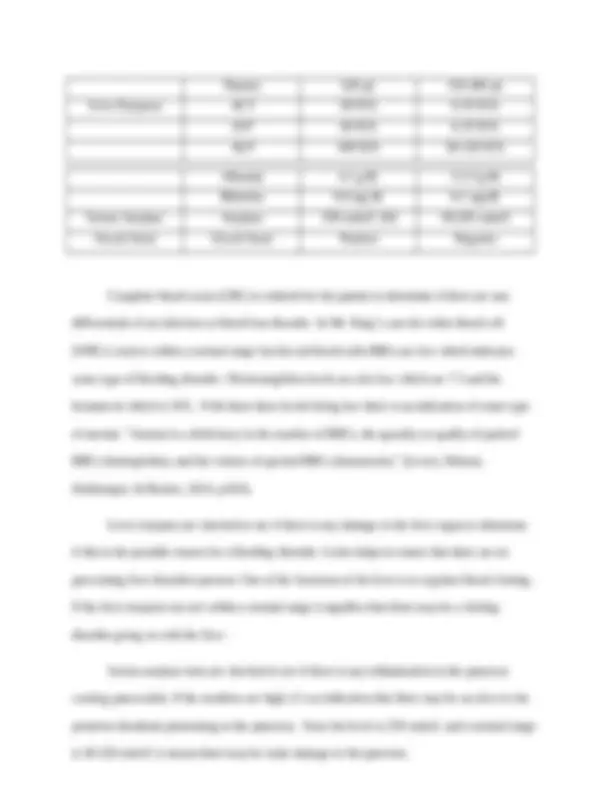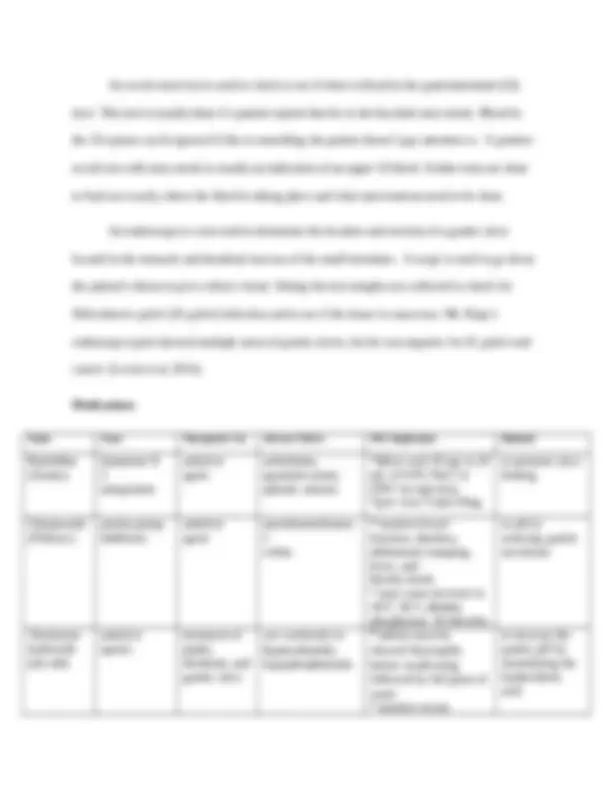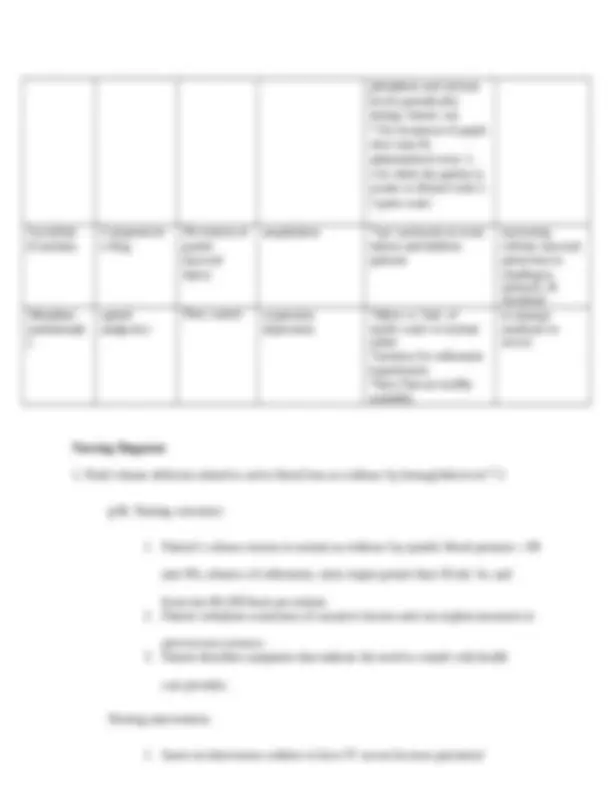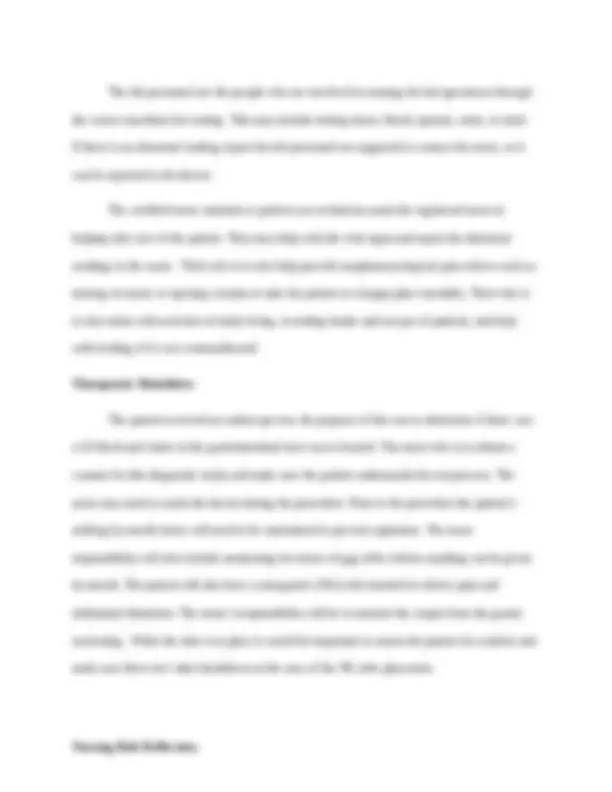








Study with the several resources on Docsity

Earn points by helping other students or get them with a premium plan


Prepare for your exams
Study with the several resources on Docsity

Earn points to download
Earn points by helping other students or get them with a premium plan
Community
Ask the community for help and clear up your study doubts
Discover the best universities in your country according to Docsity users
Free resources
Download our free guides on studying techniques, anxiety management strategies, and thesis advice from Docsity tutors
Chamberlain College of NursingNR 341 RUA Interdisciplinary Care
Typology: Study notes
1 / 10

This page cannot be seen from the preview
Don't miss anything!







RUA Interdisciplinary Care Chamberlain College of Nursing NR 341: Complex Adult Health March 2018 Interdisciplinary Care Background Information: Patient’s Name: Byron King Age: 48 Sex: Male Height: 70 inches Weight: 90.909kg Code Status: Full Code Allergies: Morphine (nausea, vomiting, and hives) Admission date: 03/18/ Admitting diagnosis: Lower Gastrointestinal (GI) Bleed Reason for admission: complaints of dark tarry stools for 2 days Occupation or former occupation: Disabled does yard work for extra money Past Medical History: Spinal cord injury (SCI) when he was 22 years old resulting in right side hemiparesis. During hospital stay at that time prescribed morphine for pain control. While taking codeine he developed an allergic reaction displaying nausea, vomiting, and generalized hives. All opioids were stopped and he was given nonsteroidal anti-inflammatory drugs (NSAIDs) as his discharge medication to take at home. Surgical history: None Situation: Mr. Byron King is a 48-year-old African American male brought into the emergency center by his wife. She states that he has been complaining of dizziness and lying around all day
which is not his usual activity. His vital signs are temperature 99.1, blood pressure 88/48, heart rate 126, respirations 14, and oxygen saturation 91%. During the nurse’s assessment Mr. King mentions to the nurse that he has been having abdominal pain on a scale of 8/10 that presents 2- hours after eating meals and at night time. He said it feels like a stabbing sensation. His abdomen is soft and tender. He stated he has dark tarry stools over the past two days in which his occult stool test came back positive. His hemoglobin blood levels is 7.3g/dL on admission and his skin has a grayish appearance. He stated his daughter’s birthday was coming up and he wanted to buy her something special. Since he is disabled and receives a check his wife depends on that for the bills. In the need of extra money, he has a small lawn cutting business that helps his family financially. Due to the weakness on his right side and old back injury he takes Ibuprofen 600mg daily before going to cut yards. The doctor created a plan for treatment of the patient and wrote orders to facilitate care. The nurse informed the patient of what the plan of care is. The doctor explained to him that he will be having a diagnostic endoscopy done to see the cause of the problem. The nurse obtained the consent and proceeded with care for the patient. She explained to him that he will no longer be allowed to have anything by mouth (NPO) and will be receiving a nasal gastric (NG) tube to help with the abdominal pain. Once admitted to the unit he was placed on NPO status, (NG) tube was placed for low suction, and he was given 2 units of packed red blood cells. The endoscopy report showed ulcers located in the gastric and duodenal mucosa. Laboratory and Diagnostic Tests Diagnostic Test (^) Element Tested Result Normal Range CBC WBC 7.5 μL 4.5-11μL RBC 3.8 mcL (L) 4.7-6.1 mcL Hemoglobin 7.3 g/dL (L) 13.5-17.5 g/dL Hematocrit 34 % (L) 41-49%
An occult stool test is used to check to see if there is blood in the gastrointestinal (GI) tract. This test is usually done if a patient reports that he or she has dark tarry stools. Blood in the GI system can be ignored if this is something the patient doesn’t pay attention to. A positive occult test with tarry stools is usually an indication of an upper GI bleed. Further tests are done to find out exactly where the bleed is taking place and what interventions need to be done. An endoscopy is a test used to determine the location and severity of a gastric ulcer located in the stomach and duodenal mucosa of the small intestines. A scope is used to go down the patient’s throat to give a direct visual. During the test samples are collected to check for Helicobacter pylori ( H. pylori ) infection and to see if the tissue is cancerous. Mr. King’s endoscopy report showed multiple areas of gastric ulcers, but he was negative for H. pylori and cancer. (Lewis et al, 2014). Medications Name Class Therapeutic Use Adverse Effects NSG Implication Rational Ranitidine (Zantac) histamine H 2 antagonists antiulcer agent arrhythmia, agranulocytosis, aplastic anemia *dilute each 50 mg in 20 mL of 0.9% NaCl or D5W for injection *give over 5 min/10mg to promote ulcer healing Omeprazole (Prilosec) proton-pump inhibitors antiulcer agent pseudomembranou s colitis ***** monitor bowel function. diarrhea, abdominal cramping, fever, and bloody stools
phosphate and calcium levels periodically during chronic use
The lab personnel are the people who are involved in running the lab specimens through the correct machines for testing. This may include testing tissue, blood, sputum, urine, or stool. If there is an abnormal reading report the lab personnel are supposed to contact the nurse, so it can be reported to the doctor. The certified nurse assistant or patient care technician assist the registered nurse in helping take care of the patient. They may help with the vital signs and report the abnormal readings to the nurse. Their role is to also help provide nonpharmacological pain relieve such as turning on music or opening curtains to take the patient to a happy place mentally. Their role is to also assist with activities of daily living, recording intake and out put of patients, and help with feeding if it’s not contraindicated. Therapeutic Modalities: The patient received an endoscope test, the purpose of this was to determine if there was a GI bleed and where in the gastrointestinal tract was it located. The nurse role is to obtain a consent for this diagnostic study and make sure the patient understands the test process. The nurse may need to assist the doctor during the procedure. Prior to the procedure the patient’s nothing by mouth status will need to be maintained to prevent aspiration. The nurse responsibility will also include monitoring for return of gag reflex before anything can be given by mouth. The patient will also have a nasogastric (NG) tube inserted to relieve pain and abdominal distention. The nurse’s responsibility will be to monitor the output from the gastric suctioning. While the tube is in place it would be important to assess the patient for comfort and make sure there isn’t skin breakdown in the area of the NG tube placement. Nursing Role Reflection:
References Lewis, S., Dirksen, S., Heitkemper, M., & Bucher, L. (2014). M. Harding (9th^ ed.), Medical- surgical nursing: assessment and management of clinical problems. St. Louis, MO: Elsvier. McBride, M., & Andrews, G. J. (2013). The Transition from Acute Care to Home: A Review of Issues in Discharge Teaching and a Framework for Better Practice. Canadian Journal Of Cardiovascular Nursing , 23 (3), 18-24. Potter, P., Perry, A., Stockert, P., & Hall, A. (2017). W. Ostendorf (9th^ ed.), Fundamentals of Nursing. St. Louis, MO: Elsvier. Sole, M., Klein, D., & Moseley, M. (2017). Nervous system alterations. (7th^ ed.), Introduction to critical care nursing. St. Louis, MO: Elsvier.